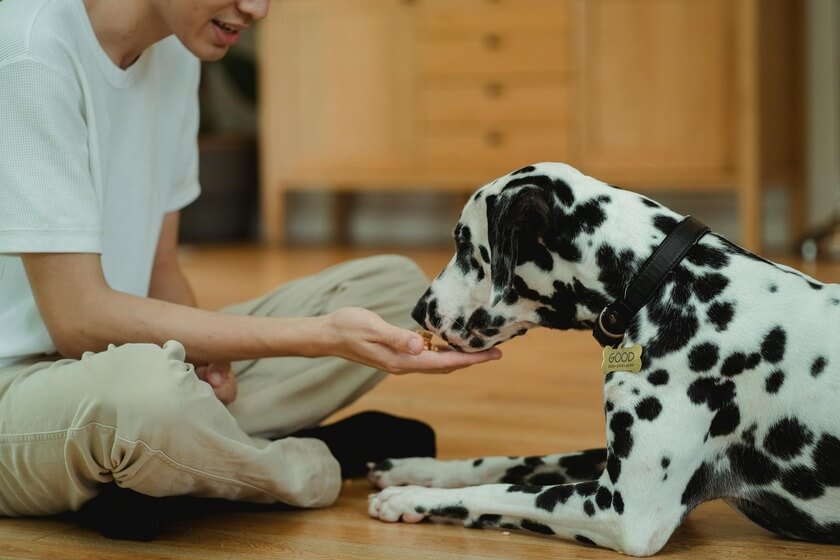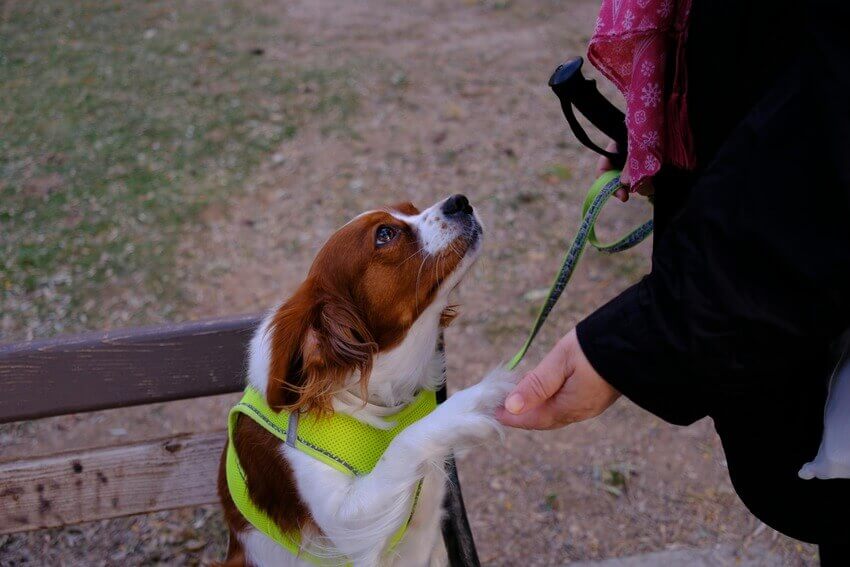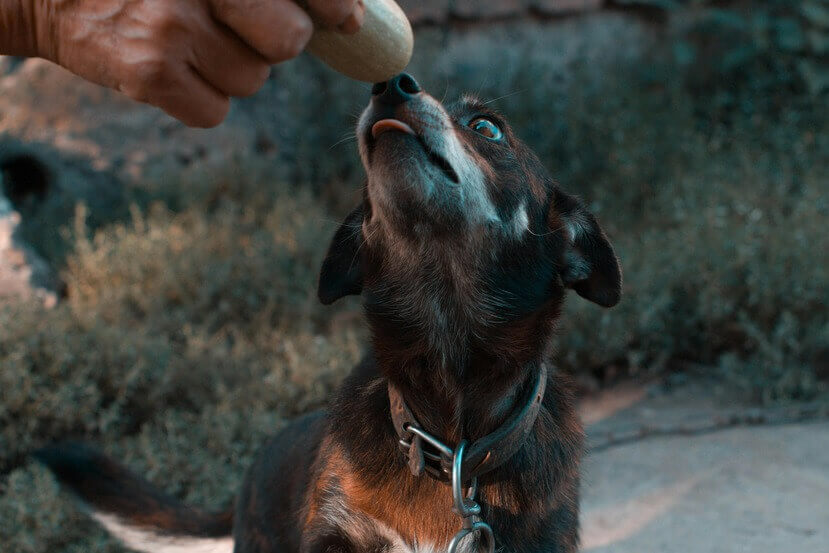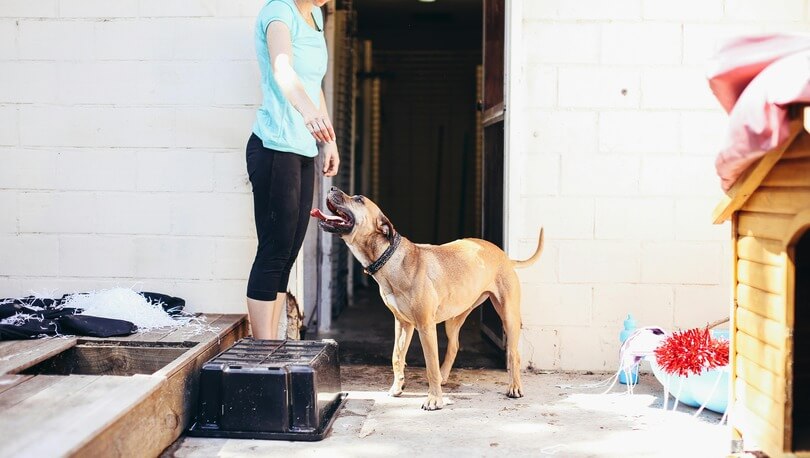What Is the Best Dog Training Collar? Reviews and Recommendations from Dog Trainers
Are you a dog owner struggling to train your furry friend?
The right dog training collar can be a valuable tool in your arsenal, helping you to teach your dog obedience, leash manners, and even address behavioral issues.
Choosing the right dog training collar can make all the difference in your dog’s behavior and overall training experience. It is key to ensuring both safety and effectiveness.
Training collars are designed to give you better control and communication with your dog, helping to guide them in learning proper behavior.
However, with so many types of collars available — from flat collars to prong collars and electronic options — it can be hard to know which one will best suit your dog’s needs. Each collar type addresses different behavior problems, and the wrong choice could lead to discomfort or ineffective training.
In this post, we’ll help you discover what is the best dog training collar for your dog by exploring expert reviews and recommendations from professional trainers.
We’ll cover the key factors to consider and offer tips on choosing the most effective and humane collar for your canine companion. By the end, you’ll have all the insights you need to make an informed decision.
Types of Dog Training Collars: Understanding Your Options
There are many types of dog training collars available, each designed to address specific training needs and behaviors.
In this section, we’ll take a closer look at the most common types of collars to help you understand your options and choose the best one for your furry companion.
Flat Collars: Everyday Use for Mild Training
Flat collars are the most common type of dog collar, often seen on dogs during casual walks or playtime. These collars are usually made of nylon or leather and feature a simple buckle or snap closure.
Best Use Cases
Flat collars are best for casual leash walks and general use when you’re not engaging in serious training. They work well for well-behaved dogs who don’t pull much on the leash. They are also suitable for dogs in training for basic commands or for those that are already comfortable on the leash.
Pros:
- Simple and comfortable
- Variety of styles
- Easy to use
- Affordable
Cons:
- Limited control
- Risk of escape
- Not ideal for serious training
Martingale Collars: Gentle Control for Escaping Dogs
Martingale collars are designed to give you more control over your dog while being gentle and comfortable. They work by tightening slightly when your dog pulls on the leash or tries to back out, but without choking or causing discomfort. This makes them an excellent choice for dogs that tend to escape from regular collars.
How Martingale collars work:
Martingale collars have a unique design with two loops. The larger loop goes around your dog’s neck, while the smaller loop is where the leash attaches.
When your dog pulls or tries to slip out, the smaller loop tightens the larger loop, gently tightening the collar around your dog’s neck.
Unlike choke collars, a Martingale collar stops tightening at a certain point, preventing discomfort or injury.
Ideal for:
- Dogs with narrow heads
- Dogs prone to escaping
Martingale collars can be a helpful tool for training dogs who tend to pull or escape. However, it’s important to use them correctly and to consult with a professional trainer if you have any concerns.
Choke Chains: Traditional but Controversial
Choke chains, also known as slip collars, have been a traditional tool in dog training for many years. These metal chains tighten around the dog’s neck when the leash is pulled, providing a quick correction for unwanted behavior.
While choke chains can be effective in certain situations and have been used for many years, there is growing concern about their safety and effectiveness.
Applications:
- Leash training
- Behavior correction like leash pulling, lunging, etc.
Many experts recommend avoiding the use of choke chains and exploring more humane and effective training methods. If you’re considering using a choke chain, it’s important to consult with a professional trainer to discuss the risks and benefits.
Prong Collars: Strong Control for Difficult Pullers
Prong collars, also known as pinch collars, are designed to provide strong control over dogs that are difficult to manage on a leash, especially those that pull excessively.
How Prong Collars Work
Prong collars are made up of interlocking metal links with blunt prongs facing inward. When the dog pulls on the leash, the prongs apply even pressure around the neck, discouraging the pulling behavior.
The design ensures that the pressure is spread out to avoid injury, but the sensation is sharp enough to capture the dog’s attention and correct the behavior.
These collars are best suited for strong, large dogs that don’t respond to regular collars or other training methods.
Professional Guidance
- Safe use: Prong collars should only be used under the guidance of a qualified professional trainer. Improper use can lead to injuries or behavioral problems.
- Potential downsides: Prong collars can be harsh and can cause discomfort or pain for dogs. They can also damage a dog’s skin or vocal cords.
If you’re considering using a prong collar, it’s important to consult with a professional trainer to discuss the risks and benefits. They can help you determine if a prong collar is appropriate for your dog and provide guidance on how to use it safely.
Electronic Collars (E-collars): Advanced Remote Training
Electronic collars, or e-collars, are used for remote dog training and can be effective tools when used correctly.
These collars come with a handheld remote that allows the owner or trainer to send signals to the collar to modify a dog’s behavior, even from a distance.
How E-collars Function
E-collars work by delivering a signal — either a vibration, beep, or static pulse — to the collar around the dog’s neck. These signals help grab the dog’s attention or correct undesirable behaviors like excessive barking, running off, or ignoring commands.
E-collars are especially useful for off-leash training, as they allow you to communicate with your dog even when they are far away.
Types of E-collars
- Vibration – These collars deliver a gentle vibration, which can be used as a mild correction or simply to get the dog’s attention. It’s suitable for sensitive dogs.
- Beep – The beep option emits a sound to alert the dog. This method can condition the dog to respond to the sound alone over time.
- Static pulse – This type delivers a small electric pulse. The intensity can be adjusted, ranging from mild to stronger corrections. Trainers use this option carefully and only when necessary to prevent serious behavior issues.
Ethical Considerations
The use of e-collars is debated among dog owners and trainers. Some experts argue that when used properly and under professional guidance, e-collars can be effective without causing harm. On the other hand, a misuse can lead to fear, stress, or confusion for the dog.
That’s why it’s crucial to use e-collars as part of a balanced training plan, with an emphasis on positive reinforcement and clear communication.
When Recommended by Trainers
E-collars are usually recommended for experienced owners or in cases where a dog’s behavior poses a risk to their safety or others (e.g., aggression, running into dangerous areas). Trainers emphasize that these collars should be used as a last resort, after other training methods have been tried.
Reviews of the Best Dog Training Collars by Trainers
In this section, we’ll dive into some of the top-rated dog training collars recommended by professional dog trainers. Whether you’re looking for a collar for basic obedience or more advanced training, these reviews will help you find the best option for your pet.
Top-Rated Flat Collars for Everyday Training
Based on reviews from trainers, here are some top-rated flat collars that stand out for their quality and effectiveness.
1. Herm Sprenger Classic Chain Collar
Pros: Durable, reliable, and classic design.
Cons: Can be harsh if used improperly.
Ideal for: Dogs who need a strong, reliable collar for leash training or behavior correction.
2. Ruffwear Front Range Harness
Pros: Comfortable, durable, and offers good control without putting pressure on the neck.
Cons: Can be more expensive than other options.
Ideal for: Dogs who tend to pull on the leash or have sensitive necks.
3. Kong Comfort Collar
Pros: Soft and comfortable, ideal for puppies or dogs with sensitive skin.
Cons: May not be as durable as other options.
Ideal for: Puppies or dogs who need a gentle and comfortable collar.
Best Martingale Collars for Dogs That Pull
Here are some Martingale collar dog trainer favorites that stand out for their quality, features, and durability.
1. PetSafe Martingale Collar
Pros: Simple design and reliable construction.
Features: Trainers appreciate the added safety of the collar’s limited slip, which prevents it from becoming too tight around the dog’s neck.
2. Blue-9 Balance Martingale Collar
Pros: Adjustability, fits a wide range of dog sizes comfortably.
Features: Has a soft fabric that makes it gentle on the dog’s skin while still providing effective control. Ideal for: active dogs because it offers both comfort and functionality.
3. LupinePet Martingale Collar
Pros: Durability and variety of fun patterns.
Features: Can withstand heavy pulling without fraying and the lifetime guarantee offered by LupinePet, ensuring that it will last through many adventures.
Highly Recommended Prong Collars for Stubborn Pullers
When used correctly, prong collars can provide effective control without causing harm.
IMPORTANT: Prong collars should only be used as a last resort and under the guidance of a qualified trainer. They can be harsh and can cause discomfort or pain for dogs.
If you’ve exhausted other training methods and your dog is still exhibiting severe pulling behavior, here are some prong collars that have been recommended by professionals:
1. Herm Sprenger Classic Prong Collar
Features: Made of high-quality stainless steel, durable and rust-resistant.
Reviews: Widely used and recommended by trainers for its effectiveness.
Safety tips: Ask a professional trainer to ensure proper fitting and usage.
2. Premier Gentle Leader Prong Collar
Features: Combines a headcollar with a prong collar for added control.
Reviews: Praised for its effectiveness in correcting pulling and redirecting a dog’s attention.
Safety tips: Use with caution and under the guidance of a trainer.
3. Gentle Touch Prong Collar
Features: Designed to be less harsh than traditional prong collars.
Reviews: Recommended for dogs who are sensitive to traditional prong collars.
Safety tips: Still requires careful use and professional guidance.
Prong collars should only be used as a last resort and under the guidance of a qualified trainer. There are many other training methods available that may be more humane and effective for your dog.
If you’re considering using a prong collar, it’s important to weigh the risks and benefits carefully.
Top E-Collars for Remote and Off-Leash Training
E-collars, or electronic collars, are popular tools for training dogs remotely and off-leash. They can help reinforce commands from a distance and improve recall.
Here’s a look at some top-performing e-collars along with trainer recommendations on their responsible use.
1. Garmin Delta XC E-Collar
Features: impressive range of up to 1 mile, offers three types of stimulation: tone, vibration, and static.
Reviews: trainers appreciate its user-friendly design, allowing easy adjustments while you train.
Trainer recommendations: Use responsibly and with positive reinforcement
2. Dogtra 1900N
Features: Long range, multiple stimulation levels, and a waterproof receiver.
Reviews: Popular choice for training dogs at a distance.
Trainer recommendations: Use responsibly and avoid excessive stimulation.
3. PetSafe YardMax
Features: Designed for containment purposes, with a range of up to 1,000 yards.
Reviews: Effective for keeping dogs within a designated area.
Trainer recommendations: Use in conjunction with positive reinforcement training.
Factors to Consider When Choosing a Dog Training Collar
Choosing the right dog training collar is essential for your dog’s safety, comfort, and overall success in training. In this section, we’ll go over the key factors you should keep in mind when selecting the best collar for your dog.
Size and Breed of Your Dog
Choosing the right dog training collar depends greatly on your dog’s size and breed. Different collars work better for small dogs versus large dogs, and certain breeds may have specific needs.
Small Dogs
Suitable collars: Harness collars, head collars, and flat collars are often good options for small dogs.
Considerations: Ensure the collar fits snugly but comfortably. Avoid collars that are too heavy or bulky.
Large Dogs
Suitable collars: Harness collars, Martingale collars, and some head collars can be effective for large dogs.
Considerations: Choose a durable collar that can withstand your dog’s strength. Avoid collars that are too small or may slip off easily.
Breed-specific Considerations
- Brachycephalic breeds (e.g., Bulldogs, Pugs): Avoid collars that put pressure on their short faces.
- Long-nosed breeds (e.g., Greyhounds, Whippets): Consider harnesses or head collars to prevent neck injuries.
- Strong pullers (e.g., Huskies, Dobermans): Martingale collars or harness collars can be effective for controlling pulling.
Training Goals
When choosing a dog training collar, it’s essential to match the collar to your specific training goals.
Different collars are designed to address different behaviors, so picking the right one can make a big difference in your dog’s training success.
1. Basic Obedience
Suitable collars: Flat collars, harness collars, or head collars are generally sufficient for basic obedience training.
Considerations: Ensure the collar is comfortable and fits properly.
2. Behavior Correction
Suitable collars: Martingale collars, harness collars, or head collars can be effective for correcting behaviors like pulling or excessive barking.
Considerations: Choose a collar that provides the necessary control without being too harsh.
3. Leash Training
Suitable collars: Harness collars, head collars, or Martingale collars can be helpful for leash training.
Considerations: Consider your dog’s pulling habits and choose a collar that provides appropriate control.
4. Specialized Training
Aggression: Consult with a professional trainer to determine the most suitable collar and training methods.
Escape artists: Martingale collars or harness collars can be effective for preventing escapes.
If you’re unsure which collar is best for your dog, consult with a professional trainer for personalized advice.
Comfort and Safety
A comfortable collar helps your dog feel secure and relaxed during training. If a collar is too tight, it can chafe or irritate your dog’s skin. On the other hand, a collar that is too loose may slip off or not provide enough control.
A well-fitting collar allows your dog to move freely while still being safe.
Tips for Choosing a Comfortable Collar
- Proper fit – The collar should fit snugly but not too tightly. You should be able to slip two fingers comfortably between the collar and your dog’s neck.
- Material – Opt for soft, breathable materials that won’t irritate your dog’s skin.
- Buckle and hardware – Ensure the buckle and hardware are sturdy and won’t break easily.
- Adjustability – Choose a collar that can be easily adjusted as your dog grows or loses weight.
- Avoid choking hazards – Avoid collars with loose straps or small parts that could pose a choking hazard.
Training Experience and Expertise
Different collars can be suitable for novice trainers or experienced handlers, depending on their understanding of dog behavior and training methods.
Novice Trainers
Recommended collars: Harness collars, head collars, or flat collars are generally suitable for novice trainers.
Considerations: Focus on basic obedience training and gradually introduce more advanced techniques.
Experienced Handlers
Recommended collars: Martingale collars, prong collars, or e-collars may be appropriate for experienced handlers with specific training goals.
Considerations: Use these collars with caution and under the guidance of a professional trainer.
When to Seek Professional Advice
- Complex behaviors
- Unsure about collar choice
- Safety concerns
By considering your training experience and seeking professional advice when needed, you can choose a collar that is both effective and appropriate for your dog’s needs.
Ready to Find the Perfect Training Collar?
Finding the perfect dog training collar is about more than just picking one off the shelf. The best dog training collar is the one that works in conjunction with the right training methods.
There’s no one-size-fits-all solution, so it’s important to consider your dog’s specific needs and training goals. The collar should also suit your dog’s unique personality and behavior.
Are they sensitive to pressure?
Do they tend to pull on the leash?
Are you dealing with specific behavioral issues?
Once you have a better understanding of your dog’s characteristics, you can begin exploring different collar options.
Based on expert recommendations, we’ve highlighted some of the most popular and effective dog training collars in this blog post. However, it’s always a good idea to do your own research and read reviews from other dog owners.
Remember, expert advice is invaluable. Exploring recommended collars based on professional reviews can give you a great starting point, but consulting with a professional dog trainer will ensure you’re using the collar correctly and safely for your dog’s particular needs.
If you’re still unsure which collar is best for your pet, don’t hesitate to reach out to us, so we can give you personalized advice and guide you in choosing the right tool for your dog’s training journey.
In fact, we have a better idea! You can come visit us, and we’ll show you how our dog trainers are effectively and safely using e-collars as part of our dog clients training sessions!
The right training collar, combined with proper guidance, can make a world of difference in your dog’s progress.
Take your time, consider your options, and choose the best collar to help your dog thrive!










